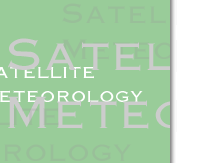



Meteorology, like every other science, relies on careful and precise measurement of its subject. Meteorologists observe the atmosphere using two basic approaches. Direct methods, also called in situ for in place, measure the properties of the air that are in contact with the instrument being used. Indirect methods, also referred to as remote sensing, obtain information without coming into physical contact with the region of the atmosphere being measured. Launching satellites into space equipped with remote sensing instruments allows us to continuosly monitor planet Earth from afar.
Satellite Meteorology refers to the study of the earth's atmosphere and oceans using data obtained from remote sensing devices flown onboard satellites orbiting the earth. |

